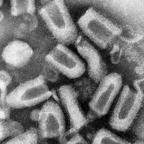| Effects/ Symptoms |
|
There is a long incubation period for this disease. It averages one to two months in humans, but can take up to a year depending on how serious it was and the locations of the infection. The head, face, and hand are the most dangerous places to be infected.
Symptoms include general malaise and restlessness. There is a growing agitation with painful spasms of the throat. Some times there is hallucinations. Soon, it's impossible to drink (one reason it's also called hydrophobia) and death usually occurs after 10 days from initial symptoms. There is a near 100% fatality rate if it goes untreated.
Wild animals most often show uncustomary behavior when they are infected. For example, a nocturnal animal would start coming out during the day. The timid would become bold.
| Possible Solutions/ Treatments/ Prevention |
It can be treated though it's usually futile after symptoms begin.
Most people who are bitten though will not catch the disease. However, vaccination should be started right away. Washing the bite thoroughly with soap is probably the best first Aid.

|
Micrograph from F. A. Murphy, School of Veterinary Medicine, University of California, Davis. |
| Links |
http://www.wadsworth.org/rabies/index.htm
| .. Back to Start |